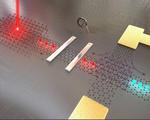Other
News Jodrell Bank leads international effort which reveals 157 day cycle in unusual cosmic radio bursts
“An investigation into one of the current great mysteries of astronomy has come to the fore thanks to a four-year observing campaign conducted at the Jodrell Bank Observatory. Using the long-term monitoring capabilities of the iconic Lovell Telescope, an international …

“A team of researchers based in Manchester, the Netherlands, Singapore, Spain, Switzerland and the USA has published a new review on a field of computer device development known as spintronics, which could use graphene as a building block for next-generation …

“Researchers from The University of Manchester, with colleagues from the universities of Groningen and Utrecht in the Netherlands, say 3D curved microchip structures could be used to develop more powerful – and energy efficient – spin-based computers. The work, published online in …

“Researchers at The University of Manchester discovered that atomically- thin micas – the name given to a type of common mineral found in soil – are excellent proton conductors. This surprising result is important for the use of 2D materials in applications …

“For the first time, a team of researchers, from the School of Materials and the National Graphene Institute at The the University of Manchester have formulated inks using the 2D material MXene, to produce 3D printed interdigitated electrodes. As published …

“A team of researchers from the Universities of Manchester, Nottingham and Loughborough have discovered quantum phenomena that helps to understand the fundamental limits of graphene electronics. As published in Nature Communications, the work describes how electrons in a single atomically-thin …

“Similar to our computers which handle electrons to perform the calculations and logics, all the circuitry in living beings is based on the transport of ions, such as sodium, chloride, calcium, etc. Nature exploits incredibly subtle transport of these elementary …

“Researchers at The University of Manchester in the UK have discovered that electrons in graphene act like a very unique liquid. The movement of electron fluid in graphene has, for the first time, been observed to exist with two separate …

“Researchers at The University of Manchester have discovered unexpected phenomena in graphite thanks to their previous research on its two-dimensional (2D) relative – graphene. The team led by Dr Artem Mishchenko, Prof Volodya Fal’ko and Prof Sir Andre Geim, discovered …

“Researchers at The University of Manchester’s National Graphene Institute in the UK have succeeded in making artificial channels just one atom in size for the first time. The new capillaries, which are very much like natural protein channels such …
